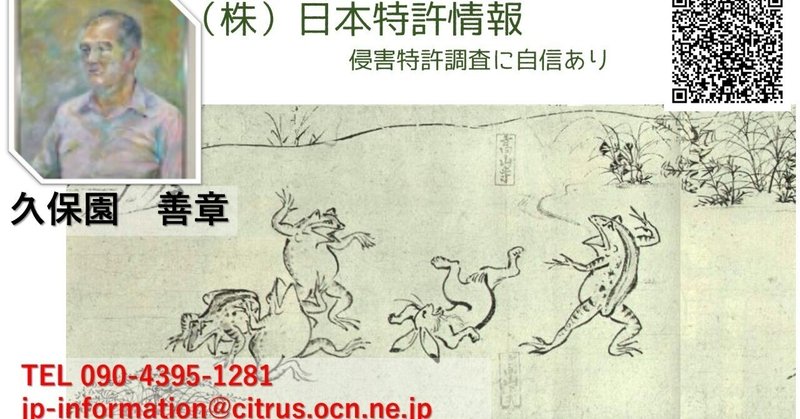
どうする特許庁! 目覚めよ審査官!! 不出来で、中途半端な「審査」(サーチ)による特許付与を、です。
知的財産高等裁判所により、「権利無効」とされたものの63件目です。
https://drive.google.com/file/d/1XyoWTMDB6FhXmhRibSvTelLVfrWr6DzA/view?usp=drive_link
特許権者である原告のウシオ電機株式会社は、自分が保有する特許第5,344,105号(光配向用偏光光照射装置及び光配向用偏光光照射方法)について、その特許の「有効性」を検証したか不明です。
「有効性」とは、自社の特許についての、例えば「無効資料調査」等を行うことで、たとえ利害関係者などの第三者からの「無効審判」を起こされても、自社の特許は盤石であると確信することです。
それにも拘らず、特許庁より与えられた特許を有効と信じて、被告である株式会社ブイ・テクノロジーを特許侵害している、と提訴しました。
先ず、東京地方裁判所により、「本件発明1ないし4についての特許は,いずれも特許無効審判により無効にされるべきものと認められる。したがって,原告は,被告に対し,本件特許権を行使することができない。」とされました。
そして、知的財産高等裁判所は、原審である東京地方裁判所の「本件発明1ないし4についての特許は,いずれも特許無効審判により無効にされるべきものと認められる。したがって,原告は,被告に対し,本件特許権を行使することができない。」を支持し、結局、控訴人は敗訴しました。
東京地方裁判所では、特許無効の根拠として、「甲26」(特開2007-114647)および「甲10」(特開2009-295950)を先行技術文献として挙げています。
このうち、前者の「甲26」(特開2007-114647)は、特許庁の審査官が特許査定時の参考文献としてあげています。
審査官は、「拒絶理由通知書」を発することなく、いきなり「登録査定」をし、出願人は特許権者となりました。
しかしながら、特許権者は知的財産高等裁判所において、上記のように敗訴しました。
本件の根本原因は、審査官が、せっかく見つけた甲26(特開2007-114647)について、これが先行技術であることを認識出来ていないことにあります。
そしてまた、「甲10」(特開2009-295950)を見つけていないことにもあります。
特許庁の審査官による、貧弱な調査力と甘い認識に基づいての、特許付与は許されません。
従って、本来なら、ウシオ電機株式会社の出願に対して、特許庁は特許を与えるべきでなかったと考えます。
この2件の「甲号証」の「出願情報」にある分類(「FI」と「Fターム」)をそれぞれの公報の右欄に付します。
これらと本件特許(特開2014-174352)の付与分類と比較して、共通(重複)するものにピンク色を付しました。多数あります。
このことより、特許庁の審査官が何故これら2件のうち、後者の「甲10」(特開2009-295950)を探し当てることが出来なかったのか不思議でなりません。
特許庁の審査官は、所謂「サーチ」ではない、正しい「先行技術調査」を学び直す必要があると思います。
「行政」(特許庁)としては、「司法」(裁判所)により誤りを指摘されたことを謙虚に反省し、その誤りを正すことを心掛けるべきです。
特に、審査官が登録調査機関の検索者を指導して作らせている「検索論理式」、又は自らが作成していると思われる「検索論理式」の作成を、根本的に改革すべきです。
( Google Translation )
What will the patent office do! Wake up Judge! !
Granting a patent through poor and incomplete "examination" (search).
This is the 63rd case that the Intellectual Property High Court has declared "invalidity".
USHIO INC., the plaintiff who is the patentee, claims that the patent's "validity ” is verified.
"Validity" means that even if a third party such as an interested party raises an "invalidation trial" by conducting, for example, an "invalid material investigation" for the company's patent, the company's patent is It is to be convinced that it is rock solid.
Despite this, we believed that the patent granted by the Patent Office was valid, and filed a lawsuit against the defendant, V-Technology Co., Ltd., alleging patent infringement.
First, the Tokyo District Court ruled, "It is recognized that the patents for Inventions 1 to 4 should be invalidated by the patent invalidation trial. I can't do it."
The Intellectual Property High Court ruled that the original trial, the Tokyo District Court, said, ``It is recognized that the patents for Inventions 1 to 4 should be invalidated by the patent invalidation trial.
In contrast, the patent right cannot be enforced.", and the appellant lost the case.
The Tokyo District Court cited "Ko 26" (Japanese Unexamined Patent Publication No. 2007-114647) and "Ko No. 10" (Japanese Unexamined Patent Publication No. 2009-295950) as prior art documents as grounds for invalidating the patent.
Of these, the former "Ko 26" (Japanese Patent Laid-Open No. 2007-114647) is cited as a reference at the time of granting a patent by an examiner at the Patent Office.
The examiner suddenly made a "decision of registration" without issuing a "notice of reasons for refusal", and the applicant became the patentee.
However, the patentee lost the case in the Intellectual Property High Court as described above.
The root cause of this case is that the examiner failed to recognize that Ko26 (Japanese Unexamined Patent Application Publication No. 2007-114647), which was found with much effort, is prior art.
And it is also because he did not find "Ko 10" (Japanese Unexamined Patent Application Publication No. 2009-295950). Patent Office examiners are not allowed to grant patents based on their poor search skills and naivety.
Therefore, I believe that the Patent Office should not have granted a patent to the application filed by Ushio Inc.
The classifications ("FI" and "F term") in the "application information" of these two "Certificate of Kou" are attached to the right column of each publication.
In comparing these with the assigned classification of the patent (JP 2014-174352), common (overlapping) items are highlighted in pink.
There are many.
This makes me wonder why the Patent Office examiners were unable to locate these two patent documents.
I think that patent office examiners need to relearn correct "prior art searches" rather than so-called "searches."
As the “administration” (the Patent Office), we should humbly reflect on the fact that the “judicial” (the court) pointed out the error, and should try to correct the error.
In particular, the creation of the "search logic formula" that the examiner instructs the searchers of the registered search organization to create, or the "search logic formula" that is considered to be created by themselves should be fundamentally reformed. is.
(Google 翻译)
专利局会做什么! 法官醒醒吧! !
通过糟糕且不完整的“审查”(检索)授予专利。
这是知识产权高等法院宣布“无效”的第63起案件。
作为专利权人的原告USHIO INC.声称该专利的“有效性”已得到验证。
“有效”是指即使利害关系人等第三方通过对公司的专利进行“无效材料调查”等方式提出“无效审判”,该公司的专利仍应被确信是坚如磐石。
尽管如此,我们仍认为专利局授予的专利有效,并对被告V-Technology Co., Ltd.提起专利侵权诉讼。
首先,东京地方法院裁定:“通过专利无效审判,认定发明1至发明4的专利无效,我不能这样做。
” 知识产权高等法院裁定,原审东京地方法院表示:“通过专利无效审判,承认发明1至4的专利应被宣告无效。
相比之下,该专利权不能得到执行。”
上诉人败诉。
东京地方法院援引“Ko 26”(日本未审专利公开第2007-114647号)和“Ko No.10”(日本未审专利公开第2009-295950号)作为现有技术文献作为专利无效的理由。
其中,在专利局的审查员授予专利时,引用以前的“Ko 26”(日本专利特开No.2007-114647)作为参考。
审查员在未发出“驳回理由通知书”的情况下突然做出“注册决定”,申请人成为专利权人。
但如上所述,专利权人在知识产权高等法院败诉。
本案的根本原因在于,审查员未能认识到经过多番努力才发现的Ko26(日本未审专利申请公开第2007-114647号)是现有技术。
还有一个事实是“Ko 10”(JP 2009-295950)尚未被发现。
专利局审查员不得因其检索能力差和天真而授予专利。
因此,笔者认为专利局不应该对Ushio Inc.的申请授予专利权。
这两份“寇证明书”的“申请信息”中的分类(“FI”和“F术语”)附在每个出版物的右栏中。
将这些与专利的指定分类(JP 2014-174352)进行比较时,常见(重叠)的项目以粉红色突出显示。
有许多。
这让我想知道为什么专利局审查员无法找到这两个专利文件。
我认为专利局审查员需要重新学习正确的“现有技术检索”而不是所谓的“检索”。
作为“行政部门”(专利局),我们应该虚心反思“司法部门”(法院)指出的错误,并努力纠正错误。
特别是,审查员指示注册检索机构的检索人创建的“检索逻辑公式”的创建,或者被认为是由其自己创建的“检索逻辑公式”的创建应该从根本上进行改革。
この記事が気に入ったらサポートをしてみませんか?
